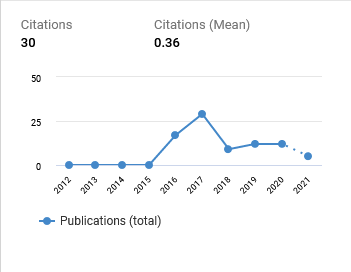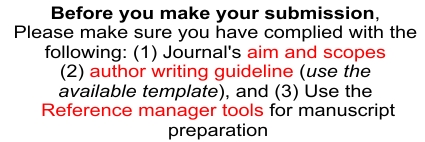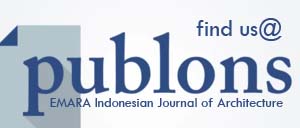Identification of Malay Architecture: Traditional Houses and Mosques in Malaysia Peninsula
DOI:
https://doi.org/10.29080/eija.v7i1.1072Keywords:
malay, mosque, malaysia, typology, traditional housesAbstract
This study aims to describe the influence of the Malay culture and customs on the Malaysian peninsula on the architectural forms of houses and mosques. The discussion is carried out on architectural elements with the object of discussion of houses and mosques. The traditional Malay house has a house topology on stilts with high poles, a layered roof, the primary material with wooden structures, and many openings (ventilations) that illustrate adaptation to the tropical climate. The type of house is determined by its roof shape, namely Bumbung Panjang, Bumbung Limas, Bumbung Perak, and Bumbung Perak Bumbung Limas. On the other hand, a mosque is a very important building for the Malay community because it is a space for congregational prayer and a formal education/teaching center for religious education, and an administrative center for communities. The overall impression of the mosque is described as a building with a flat hypostyle roof. This typology follows a religious concept of Malaysian people regarding many aspects of design on the holiness of mosques designed to develop seven architectural elements
Downloads
References
Afifi, H. M. (2017). Thermal Comfort in Rumah Kutai. Proceedings of International Conference on Architecture 2017 (ICRP-AVAN), 5.
Ahmad, A. A. (2015). Ruang dalaman Masjid Melayu tradisional Semenanjung Malaysia. Akademi Pengajian Islam, Universiti Malaya.
al-Āṭī, Ḥammūdah ʻAbd. (1998). Islam in Focus. American Trust Publications.
Angkasa, Z. (2016). Arsitektur Melayu Berbasis Islam dan Relevansinya dalam Desain Gedung UIN Raden Fatah Palembang. 1–14.
Asif, N., Utaberta, N., & Sarram, A. (2019). Architectural Styles of Malaysian Mosque: Suitability In Compact Urban Settings. MATEC Web of Conferences, 266, 06001. https://doi.org/10.1051/matecconf/201926606001
Azhari, N. F. N., & Mohamed, E. (2012). Public Perception: Heritage Building Conservation in Kuala Lumpur. Procedia - Social and Behavioral Sciences, 50, 271–279. https://doi.org/10.1016/j.sbspro.2012.08.033
Aziz, S. M. (2013). The Construction of Malay Identity In The Media: A Literature Review. The 9th Regional Symposium of the Malay Archipelago 2012, 1–16. https://jadinti.uitm.edu.my/images/Volume22_Dec2018/INTIV22Dec2018_Complete_V1.pdf
Brace, C. L. (2003). The concept of race in physical anthropology. Research Frontier, 240–255.
Choo, I. A. H., Rashid, M. S. A., & Jamaluddin, N. H. (2020). The typology of rumah limas bumbung perak (RBLP). Planning Malaysia, 18(2). https://doi.org/10.21837/pm.v18i12.740
Collins, P. (1998). Changing Ideals in Modern Architecture, 1750-1950 (2nd edition). McGill-Queen’s Press - MQUP.
Effendy, T. (2013). Lambang dan falsafah dalam seni bina Melayu. Yayasan Tenas Effendy bekerjasama dengan Dinas Kebudayaan dan Pariwisata, Provinsi Riau, Indonesia.
Embong, A. M., Jusoh, J. S., Hussein, J., & Mohammad, R. (2016). Tracing the Malays in the Malay Land. Procedia - Social and Behavioral Sciences, 219, 235–240. https://doi.org/10.1016/j.sbspro.2016.05.011
Firzal, Y. (2011). Malay House, an Uniqueness of Architetural Design Form. Local Wisdom : Jurnal Ilmiah Kajian Kearifan Lokal, 3(1), 19–24. https://doi.org/10.26905/lw.v3i1.1388
Gaspersz, S. G. (2017). Masuk Melayu: Menegosiasikan Islam dan Kemelayuan di Malaysia. Civic-Culture: Jurnal Ilmu Pendidikan PKN dan Sosial Budaya, 1(1). https://doi.org/10.31219/osf.io/wdm5c
GhaffarianHoseini, A., & Dahlan, N. D. (2012). The Essence of Malay Vernacular Houses: Towards Understanding the Socio-cultural and Environmental Values. Journal of the International Society for the Study of Vernacular Settlements (ISVS e-Journal), 2(2), 53–73.
Harun, S. N. (2005). Sejarah_dan_Pengaruh_Senibina-with-cover-page-v2.pdf. Buletin Perancang, JPBD, UiTM Perak, 100.
Hassan, A. S., & Nawawi, M. S. A. (2014). Malay Architectural Heritage on Timber Construction Technique of the Traditional Kampung Laut Old Mosque, Malaysia. Asian Social Science, 10(8), p230. https://doi.org/10.5539/ass.v10n8p230
Hassan, A. S., & Ramli, M. (2010). Natural Ventilation of Indoor Air Temperature: A Case Study of the Traditional Malay House in Penang. American Journal of Engineering and Applied Sciences, 3(3), 521–528. https://doi.org/10.3844/ajeassp.2010.521.528
Hosseini, E., Mursib, G., & Shahminan, R. N. R. (2016). Implementation of Traditional Malay Design Values in Contemporary Malay Houses. International Journal of Built Environment and Sustainability, 3(2), Article 2. https://doi.org/10.11113/ijbes.v3.n2.125
Johar, S., Che-Ani, A. I., Tawil, N. M., Surat, M., & Kamaruzzaman, S. N. (2013). Preliminary Survey and Defects Analysis of Traditional Timber Mosques in Malaysia. Wseas Transactions on Environment and Development, 9(1), 11.
Lim, J. Y. (1987). The Malay House: Rediscovering Malaysia’s Indigenous Shelter System. Institut Masyarakat.
Nasir, A. H. (1985). Pengenalan Rumah Tradisional Melayu Semenanjung Malaysia. Darul Fikir.
Nasir, A. H. (1995). Seni bina masjid di dunia Melayu-Nusantara. Penerbit Universiti Kebangsaan Malaysia.
Prayogi, A. (2016). Dinamika Identitas Budaya Melayu Dalam Tinjauan Arkeo-Antropologis. Tamaddun: Jurnal Kebudayaan dan Sastra Islam, 16(1), 1–20.
Rasdi, M. T. M., & Tajuddin, M. (2007). Mosque architecture in Malaysia: Classification of styles and possible influence. Journal Alam Bina, 9(3), 1–37.
Rumondor, P., & Manese, R. M. (2020). Eksistensi Masjid Di Perkotaan dalam Pengembangan Pendidikan Agama Islam. In Proceding The First International Conference on Islamic Thought (ICIT) IAI Al Khairat. The First International Conference on Islamic Thought (ICIT) IAI Al Khairat, PAmekasan. IAI Al Khairat. https://doi.org/10.31219/osf.io/s3cjh
Said, S., & Embi, M. R. (2008). A Parametric Shape Grammar of the Traditional Malay Long-Roof Type Houses. International Journal of Architectural Computing, 6(2), 121–144. https://doi.org/10.1260/147807708785850113
Sandelowski, M., Leeman, J., Knafl, K., & Crandell, J. L. (2013). Text-in-context: A method for extracting findings in mixed-methods mixed research synthesis studies. Journal of Advanced Nursing, 69(6), 1428–1437. https://doi.org/10.1111/jan.12000
Tamrin, H. (2017). Enkulturisasi dalam kebudayaan melayu. Al-Fikra: Jurnal Ilmiah Keislaman, 14(1), 98–148. https://doi.org/10.24014/af.v14i1.3903
Utaberta, N., & Rasdi, M. T. M. (2010). Deskripsi tipologi, klasifikasi dan analisis perancangan masjid di malaysia. El-Harakah, 12(3), 179–193. https://doi.org/10.18860/el.v0i0.451
Wahab, M. H. A., & Bahauddin, A. (2019). The spatial organization of the Negeri Sembilan traditional house, Malaysia. Journal of Comparative Cultural Studies in Architecture, 21–28.
Yusoff, Y. M., & Sulaiman, M. A. (2004). Kajian Tentang Maklum Balas Masyarakat Terhadap Aktiviti Masjid-masjid Negeri di Semenanjung Malaysia. Jurnal Usuluddin, 20, 201–222.
Zain, Z. (2016). The Ecological Responsive Buildings: Traditional House in the Kapuas Riverside of West Kalimantan. Komunitas: International Journal of Indonesian Society and Culture, 8(2), 295–308. https://doi.org/10.15294/komunitas.v8i2.5836

Downloads
Published
How to Cite
Issue
Section
Categories
License
Copyright (c) 2021 Zairin Zain, Najwa Amalia Uray, Silvia Christabella

This work is licensed under a Creative Commons Attribution-ShareAlike 4.0 International License.
- Authors retain copyright and grant the journal right of first publication with the work simultaneously licensed under a Creative Commons Attribution ShareAlike License that allows others to share the work with an acknowledgment of the work's authorship and initial publication in this journal.
- Authors are able to enter into separate, additional contractual arrangements for the non-exclusive distribution of the journal's published version of the work (e.g., post it to an institutional repository or publish it in a book), with an acknowledgment of its initial publication in this journal.
- Authors are permitted and encouraged to post their work online (e.g., in institutional repositories, pre-print sites, or on their website) prior to and during the submission process, as it can lead to productive exchanges, as well as earlier and greater dissemination of published work.
































